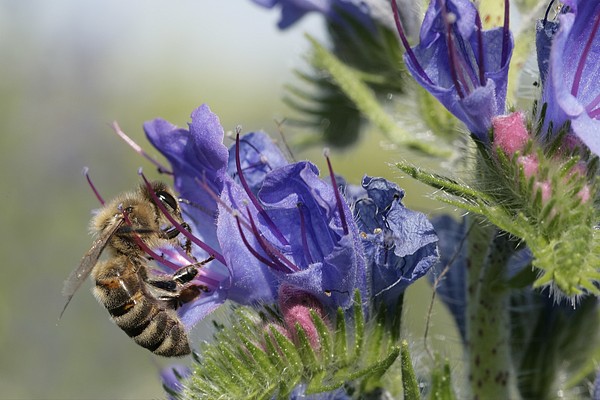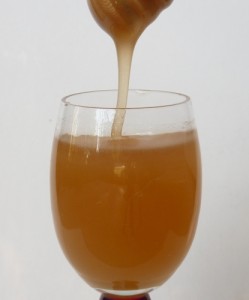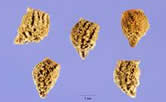Viper’s Bugloss honey is a yellow gold color with a light clean taste, a floral bouquet and lemon characteristics. It is high in fructose which makes it slow to crystallize. It is delicious in tea or coffee and compliments a strong cheese such as blue or Roquefort. In honey tastings it is often among the favorites by men, although also enjoyed by women.
Viper’s Bugloss (Echium vulgare) honey is also known as Borage honey or Blue Borage honey. This should not be confused with honey made from Borage (Borago officinalis), a commercially grown plant used for seed oil, nor with honey from Purple Viper’s Bugloss (Echium plantagineu), popularly known in Australia as Patterson’s Curse.
Viper’s Bugloss is a wild plant that enjoys dry meadows and fields, waste places and roadsides. It grows tall and its beautiful blue wildflowers – rarely white or pink – flower from late spring to mid-summer.
A member of the Borage family, it is native to southern Europe but is found in most countries from United States to New Zealand. It is often one of the many blossoms contributing to multifloral honeys from around the world, but in single flower honeys where it accounts for at least 45% of the content, New Zealand is the primary source. Mainly from the Southern island where it grows wild in the dry mountain valleys and mountain sides during the summer months. This pure environment is ideal because of the low risk of pesticide and chemical contamination.
The name Viper’s Bugloss came about from a perceived resemblance between the seeds and a viper’s head, or the spots on the stem like a viper’s skin. It was thought to be a useful antidote to snakebite based on the fanciful logic of 14th century herbalist’s Doctrine of Signatures that states that the appearance of a plant indicates its use to humanity. In his 1656 The Art of Simpling, herbalist William Coles described the plant: “its stalks all to be speckled like a snake or viper, and is a most singular remedy against poison and the sting of scorpions.” The Latin name Echium originates ultimately from the Greek word, echis for viper, while bugloss is derived from the Greek for Ox Tongue a reference to the shape and roughness of the leaves.
Latin name: Echium vulgare, Borage Family (Boraginaceae)
Sources: New Zealand, Sicily and Sardinia; Around the Mediterranean (Italy, Morocco, Spain, Turkey) and South America (Chile)
AKA: Blue Bottle, Blue Weed, Wild Borage, Bugloss, Viper’s Bugloss, Cat’s-tail, Blue Cat’s-tail, Viper’s Grass, Iron-weed, Langdebeef, Our Lord’s Flannel or Our Saviour’s Flannel, Snake Flower, Snake’s Bugloss, Viper’s Herb, Blue Thistle, Blue Devil, pa’ qué te quiero mañosa (Spanish – “pa’ do you want to touch”—a reference to its thorns)
Translations: Italian: Miele di Erba Viperina, German: Gewöhnlicher Natternkopf honig, French: Le miel de vipérine, Spanish: Miel de Bugloss de la víbora
Image Credits: Image with bee: by Arne Ader, Closeup by Luis de Pablos Alcázar






hello
just to let you know that in Britain, borage is a different plant although from the same family
it’s Borago officinalis
viper’s bugloss is Echium vulgare
I am a French beekeeper and used to live in the UK, borage honey is very good…
Is it true that Blue Borage honey from Honeyland in New Zealand contains high levels of pyrrolizidine alkaloids and is dangerous to eat daily? If so,does it exist in other honeys?
Thank you,
Dorothy Moss
Hi Dorothy:
Good question. It is true that it does contain pyrrolizidine alkaloids, but as I noted in the health considerations, unless pregnant or breastfeeding or toddler age and less, it is considered safe if eaten infrequently. Pollen products from Blue Borage should be avoided completely.
Many plants (up to 3% of all plants) contain pyrrolizidine alkaloids and recent scientific studies are investigating risk of honey and other foods. For a detailed scentific opinion, see: Scientific Opinion on Pyrrolizidine alkaloids in food and feed1; EFSA Panel on Contaminants in the Food Chain (CONTAM)2, 3; European Food Safety Authority (EFSA), Parma, Italy
Scott
I have a few questions:
How much Viper’s Bugloss would have to be around for my honey to contain alkaloids?
If the pollen is blue, would I be able to tell easily if they were working Viper’s Bugloss?
I’m asking because it’s become somewhat invasive in my area and I don’t want it in my honey because.
Thanks,
Ken
Hi Ken:
Interesting question. There would have to be quite a lot, but it does bloom throughout the summer so it will be present in most honey. The only way, besides actually testing for pyrrolizidine alkaloids (do a google search for, “testing procedure for pyrrolizidine”), would be to do a pollen count and extrapolate from that the percentage of nectar and therefore pyrrolizidine. You do need some equipment to do a pollen count. Here is a general description of pollen analysis.
…Scott